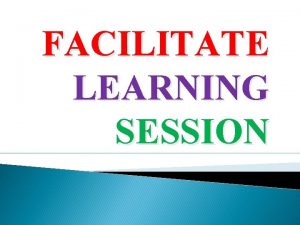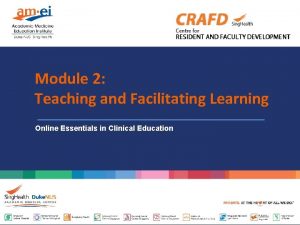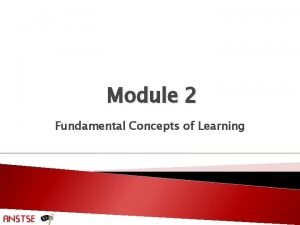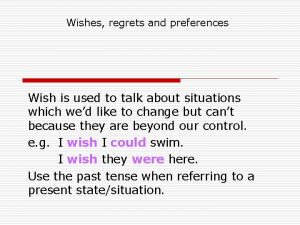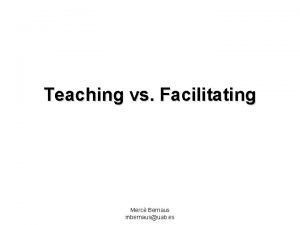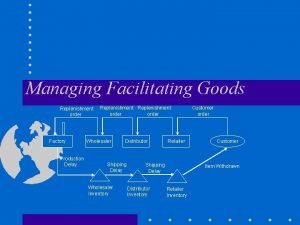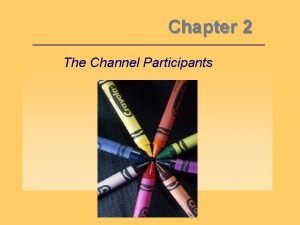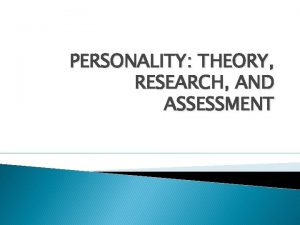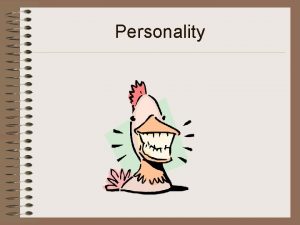Facilitating Learning Personality Preferences and Student Learning Online

















- Slides: 17

Facilitating Learning Personality Preferences and Student Learning

Online Indicators: Take one of these online indicators before moving on. �www. humanmetrics. com �www. personalitypage. com

Four Scales Measured by MBTI Scale Refers to Extraversion/Introversion How a person is energized Sensing/Intuition What a person pays attention to Thinking/Feeling How a person decides Judging/Perceiving Life-style a person adopts

Personality Preferences �While MBTI preferences influence learning styles, personality preferences encompass the whole person and the way he/she lives life, which, of course, includes learning as part of the whole.

Energy �Extraversion: Preference for drawing energy from outside world of people, activities or things. �Introversion Preference for drawing energy from one’s internal world of ideas, emotions or impressions.

Attending �Sensing Preference for taking in information through the five senses and noticing what is actual. �Intuitive Preference for taking in information through a “sixth sense” and noticing what might be.

Deciding �Thinking Preference for organizing and structuring information to decide in a logical, objective way. �Feeling Preference for organizing and structuring information to decide in a personal, value-oriented way.

Organizing �Judging Preference for living a planned, organized life. �Perceiving Preference for living a spontaneous and flexible life.

Types and Preference Levels E I S N T F J P 60 50 40 30 20 10 20 30 40 50 60

Sixteen “Types” ISTJ Dependable 6% ISFJ Nurturing 6% INFJ Loyal 1% INTJ Perfectionist 1% ISTP Logical 6% ISFP Artistic 6% INFP Idealist 1% INTP Analytical 1% ESTP Spontaneous 13% ESFP Performer 13% ENFP Inspirer 5% ENTP Visionary 5% ESTJ Decisive 13% ESFJ Caregiver 13% ENFJ Helper 5% ENTJ Strategic 5%

Things to remember �People aren’t neatly categorized. Life is too messy for that. Indicators are based on a continuum. �Indicators are based on preferences. �Goal is to be balanced, using preferences from both sides of the scale.

Energy and Learning Extroverts: Introverts: Like variety and action Like quiet for concentration Impatient with long, slow assignments like research. Like working on one assignment for longer periods of time Often speak and act quickly, sometimes without putting in enough thought Like to take time to think before speaking or acting Develop ideas by discussion Develop ideas by reflection Like working with others Like working alone or with one person Ask questions to check on expectations Ask questions to understand something before attempting Has a relatively short attention span Work intently on task at hand

Attention and Learning Sensors Intuitives Like using experience to solve problems; likes to be practical Like solving new and complex problems; likes to be innovative Enjoy using skills already learned more than learning new ones Enjoy learning a new skill more than using it. Is more observant than imaginative; rarely makes errors of fact Is more imaginative than observant; jumps to conclusions Prefers memorizing Prefers conceptualizing Likes to know the “right way” to solve problems Likes to find different ways to solve problems Likes precise, detailed work Dislikes precise work with many details Usually proceed step-by-step Usually work in bursts of energy

Deciding and Learning Thinkers Feelers Use logical analysis to reach conclusions Use values to reach conclusions Can work without harmony Work best in harmony with others Tend to decide impersonally, sometimes paying insufficient attention to others Tend to decide let decisions be influenced by their own and other people’s likes and dislikes Are motivated by ideas Are motivated by people Tend to be firm minded and can give criticism when appropriate Tend to be sympathetic and dislike, even avoid, providing criticism Prefer to be brief and concise Prefer to be sociable and friendly Feel rewarded when job is done Feel rewarded when people’s needs are met

Organizing and Learning Judgers Perceivers Work best when assignments are structured and deadlines are firm Enjoy flexibility in assignments Like things settled and definite Like to leave things open for lastminute changes. Are more decisive than curious Are more curious than decisive May notice new things that need to be done May postpone unpleasant tasks that need to be done State their positions and decisions clearly Present their views as tentative and malleable Expect others to follow through and Expect others to adapt to count on it situational requirements Like to communicate results Like to communicate options and opportunities

Tutoring Goals �Remain aware of different preferences that inevitably occur in the classroom �Provide opportunities for students to work with and against preferences. �Understand the difficulty students have when working with their non-dominant preference

Sources �Lawrence, Gordon. People Types and Tiger Stripes. Center for Applications of Psychological Type, 1993. �Myers, Isabel Briggs. Gifts Differing. Palo Alto: Consulting Psychologists, 1980. �Scharton, Maurice and Jan Neuleib. Inside Out: A Guide to Writing. Boston: Allyn and Bacon, 1993.
 Child and adolescent development and facilitating learning
Child and adolescent development and facilitating learning Benchwork area
Benchwork area Facilitating learning module 2
Facilitating learning module 2 Different ways to learn
Different ways to learn Sls reset password
Sls reset password Wishes and regrets
Wishes and regrets Career choices and preferences in hrm
Career choices and preferences in hrm How to reorder artboards in illustrator
How to reorder artboards in illustrator Teaching vs facilitating
Teaching vs facilitating Facilitating goods
Facilitating goods Merchant wholesalers
Merchant wholesalers What is channel participants
What is channel participants Marketing channel concept
Marketing channel concept Factors influencing human communication
Factors influencing human communication Facilitating cultural change
Facilitating cultural change Developing service products core and supplementary elements
Developing service products core and supplementary elements Example of value
Example of value Robert peck's stages of psychological development
Robert peck's stages of psychological development

